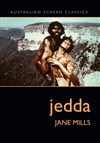| Jane Mills, Jedda Currency Press, 2012 ISBN: 9780-86819-920-7 Au$16.95 (pb) 89pp (Review copy supplied by Currency Press) |
 |
This ‘little book’ Jedda contains big ideas, conflicting ideas, ideas from the past and present. As part of the ‘Australian Screen Classics’ series Jane Mills presents an impassioned and insightful critique of Chauvel’s 1955 film Jedda. In keeping with the publisher’s brief, Mills writes about a film she feels passionate about, not about her favourite film, or the film she loves most of all, but a film she is conflicted over. Mills is ‘passionate’ in an academic, film studies kind of a way, intrigued by the film’s riddles, mismatched accents and dislocated landscapes, but she is also passionate about the film in a purely subjective way. Together these approaches enrich the text.
The book opens with an admission, a confession to an obsession of sorts. Mills tells of her mission to understand the contradictions, the jarring inconsistencies and the racism so evident in the film. She tells of her initial struggle and inevitable quest to understand the film, involving her journey to the actual locations shot by Chauvel. Mills provides a personal and endearing account of her impressions of both the real and represented landscape so important to this film. In contrast to which she digs deep into film theory, comparing the mix of genres used and Chauvel’s use of landscape in the film. More significantly, Mills acknowledges the importance of landscape or ‘country’ to Indigenous people. She very effectively gives voice to the concerns of many Aboriginal people who find the cultural and actual dislocation of the film’s main characters mirrors the effect of racial politics in this country.
It is obvious to the reader that the author is very knowledgeable, has a broad understanding of film theory, plot and story analysis, genre and most importantly, she can make sense of it. Further, Mills is able to give examples of novels and films that illustrate her point as well as those that influenced Chauvel’s vision and the style of the film. This ‘literature review’ of sorts is interesting, subtle and goes a long way to explaining the difficulties that some of us have with the film. Further, these texts give context to Chauvel’s film Jedda.
With the help of biographical material and location photographs Mills paints a picture of the cultural and emotional difficulties faced by the young actress Rosalie Kunoth, her distress at breaking customary law while acting and her shock when viewing the finished film. This material not only paints a rich picture, but helps explain aspects of Rosalie’s performance. The author’s exploration of the character ‘Joe’, the mixed blood, head stockman with the dubious Oxbridge accent, painted face, and questionable parentage gives new insights into some of the most jarring aspects of the film. This background material highlights the lack of Indigenous voice in the film and questions Chauvel’s part in creating images that proffered white colonial rule
Mills teases out what is for her the core problem with the film’s narrative, then digs a little deeper exploring the characters (of which the landscape is central). Further, each section makes sense of the juxtaposition of race politics, lust, desire and customary law. Insightfully, Mills relates the dislocation of the landscapes used in the ‘travelogue’ or backdrop to the flight and pursuit of Marbuk and Jedda to the historical and cultural dislocation of Indigenous people. Country is, after all, incredibly important to Aboriginal identity. In the modern context, Mills notes the struggle between white civilization and Indigenous culture, between homestead and walkabout and the impact of the stolen generation, assimilation, ‘apartness’ and race politics then and now. Mills does a good job of describing the difficulties associated with representing Aboriginal people and culture through a western oriented gaze. Mills not only highlights the film’s inherent racism, but shows how politically incorrect the depiction of race could be in the 1950s. How many white actors are described by film critics as ‘white’? Why was Jedda (Rosalie Kunoth) described as the ‘comely chocolate heroine’ or Marbuk (Robert Tudawali) as a ‘weird looking tribal barbarian’? Uncomfortable with the overt racism of the film and its publicity, Mills admits that she cannot love Chauvel’s Jedda.
Mills does not offer an authoritative voice, does not gloss over the racism or issues relating to giving other people’s children away. She does not try to justify them, apologize for them, nor try to tell the reader or viewer what to think of them, but rather acknowledges the range of Indigenous and non-Indigenous responses to the film. Importantly, for film students Mills clearly illustrates how each viewer co-authors and gives meaning to what they see depicted on the silver screen, and how that meaning is constantly updated, reviewed and made anew.
I was surprised at how much was crammed into these pages. I also underestimated how long it would take to read – well written, intelligent texts are like that. It would have taken much longer if I had stopped to watch the scenes described when I wanted to. My advice to the reader is to take some time to reflect between sections, if you can’t help yourself, stop and watch the scenes that Mills discusses and as a last resort, take the pilgrimage. This ‘little book’ is thought provoking but most importantly invites the reader to watch Chauvel’s film Jedda again and again. One gets the impression that one more viewing will not be enough.
